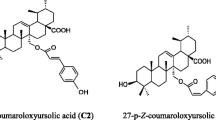Abstract
Purpose: Studies were conducted on oryzalin (3,5-dinitro-N,N-di(n-propyl)sulfanilamide), a widely used dinitroaniline sulfonamide herbicide, which was identified from plant extracts as an inhibitor of mitogen- and growth factor-mediated intracellular free Ca2+ ([Ca2+]i) signalling in mammalian cells. Methods and Results: Oryzalin inhibited vasopressin, bradykinin and platelet-derived growth factor [Ca2+]i signalling in Swiss 3T3 fibroblasts with IC50 values of 14, 16 and 18 μM, respectively. 45Ca2+ uptake into nonmitochondrial stores of saponin-permeabilized Swiss 3T3 cells was inhibited by oryzalin with an IC50 of 34 μM. Oryzalin inhibited colony formation of HT-29 colon carcinoma cells with an IC50 of 8 μM and inhibited the growth of a number of other cancer cell lines and primary human tumors in vitro with IC50 values in the range 3 to 22 μM. A number of oryzalin analogues were studied and an association was found between the ability to inhibit [Ca2+]i signalling and inhibition of the growth of HT-29 human colon cancer cells (P=0.001) and of CCRF-CEM human leukemia cells (P=0.016). Oryzalin at doses up to 600 mg/kg administered orally or subcutaneously daily to mice for 3 to 10 days beginning a day after tumor inoculation inhibited the growth of murine B16 melanoma by 63% but showed no appreciable activity when administered subcutaneously or intraperitoneally to mice beginning a number of days after tumor inoculation against a variety of human tumor xenografts. The peak plasma concentration of oryzalin following repeated subcutaneous administration of oryzalin at 600 mg/kg per day to mice was 37 μM and of its major metabolite N-depropyl oryzalin was 53 μM. Conclusion: It is unlikely that the absence of significant antitumor activity of oryzalin is a result of the inability to achieve adequate plasma concentrations.
Similar content being viewed by others
Author information
Authors and Affiliations
Additional information
Received: 24 December 1996 / Accepted: 20 March 1997
Rights and permissions
About this article
Cite this article
Powis, G., Gallegos, A., Abraham, R. et al. Inhibition of intracellular Ca2+ signalling, cytotoxicity and antitumor activity of the herbicide oryzalin and its analogues. Cancer Chemother Pharmacol 41, 22–28 (1997). https://doi.org/10.1007/s002800050703
Issue Date:
DOI: https://doi.org/10.1007/s002800050703




